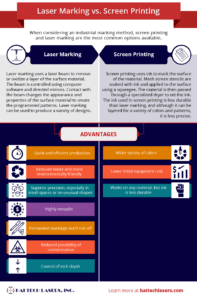When considering an industrial marking method, screen printing and laser marking are the most common options available. Screen printing has long been a popular marking method and is useful for the creation of colorful designs. When marking logos, bar codes, and measurements, laser marking is more precise and longer-lasting. In addition to its high level of accuracy, laser marking is quicker and cleaner than screen printing. Below is a comparison of each method to help you determine which process is right for your needs.
How Do They Work?
Laser marking and screen printing use distinctly different equipment. Although laser marking equipment is more expensive than screen printing, it requires fewer supplies and less labor.
Laser Marking Method
Laser marking uses a laser beam to remove or oxidize a layer of the surface material. The beam is controlled using computer software and directed mirrors. Contact with the beam changes the appearance and properties of the surface material to create the programmed patterns. Laser marking can be used to produce a variety of designs, including company logos, bar codes, measurements, and complicated geometric designs. The laser’s power may be increased to etch designs or decreased to simply discolor the surface.
Screen Printing Method
Screen printing uses ink to mark the surface of the material. Mesh screen stencils are soaked with ink and applied to the surface using a squeegee. The material is then passed through a specialized dryer to set the ink. The ink used in screen printing is less durable than laser marking, and although it can be layered for a variety of colors and patterns, it is less precise. This makes it less useful for industrial applications than laser marking.
Key Criteria and Performance Factors
Both screen printing and laser part marking are viable methods for marking materials in a wide range of applications. To ensure that you are using the best method for your needs, it is important to consider the following key performance factors:
- Material to be marked. Screen printing is viable on nearly all materials, including fabric and industrial products, though it is less durable than laser marking. Laser marking is ideal for industrial applications, as it can be used for a wide range of high quality and hard materials, including metals, ceramics, plastics, and glass.
- Marking colors. Since silk screening uses ink to mark materials, it is available in a wide variety of colors and patterns. Laser marking removes a layer from the surface of the material being marked, which limits the print color to that of the heated material. For industrial uses, this is sufficient to ensure a visible and long lasting mark.
- Equipment and training. Silk screen printing equipment is inexpensive and requires little training to operate—however, it is less precise and highly labor intensive. For industrial and manufacturing uses, laser marking is quicker, more efficient, and of higher quality. The higher cost of the laser equipment is offset over time by the reduced cost of production and materials.
- Accuracy. Screen printing equipment is difficult to calibrate for precise markings. Although screen printing can be used to create multicolored patterns, the equipment is not very accurate. Laser marking machine can be programmed to produce extremely small and detailed designs with an exceptional degree of precision, making this method ideal for use in industrial production.
- Versatility. Screen printing can only be applied to flat materials, whereas laser marking allows the user to print on multiple axes, facilitating precise printing on small or unusually shaped surfaces.
- Durability. Ink from screen printing bonds to the surface material and may fade or be removed with continued rubbing or contact, making it poorly suited for surfaces that may experience abrasion or frequent human contact. Laser marked etchings cannot be rubbed away.
- Production speed and quantity. Silk screening requires extensive preparation and cleanup. Laser marking, however, is highly automated and requires very little time to set up. Once the parameters are programmed, a laser marking machine will complete the mark within seconds. This is especially useful for large production runs and can significantly reduce production costs.
Advantages of Screen Printing
- Wider variety of colors
- Lower initial equipment cost
- Works on any material, but ink is less durable
Laser Marking Advantages
- Quick and efficient production
- Reduced waste and more environmentally friendly
- Superior precision, especially in small spaces or on unusual shapes
- Highly versatile
- Permanent markings won’t rub off
- Reduced possibility of contamination
- Control of etch depth
Overall, laser marking is the superior solution for the production of highly accurate and efficient marked and engraved industrial products.
Learn More about Laser Marking Solutions from Hai Tech Lasers
For more than 30 years, Hai Tech Lasers has been a premier provider of superior laser marking and engraving services. For more information, contact us today or request a quote.

